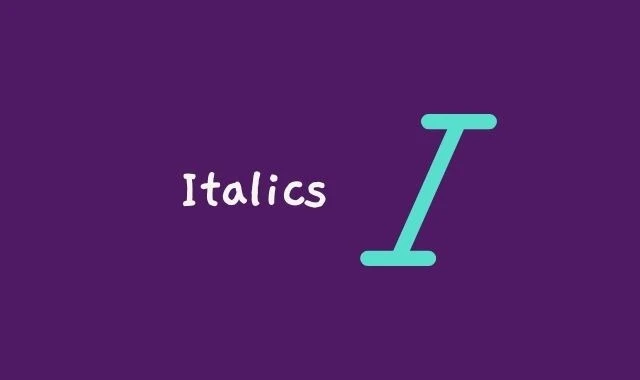Italics
Introduction
Imagine you're reading a captivating novel, a riveting newspaper article, or even a heartfelt email from a friend. What captures your attention? Sometimes, it's the subtle use of italics that adds depth and clarity to the text. Whether you're a seasoned author, a diligent student, or simply someone who loves to communicate effectively, understanding the art of using italics can transform your writing. Let's explore how this seemingly simple typographic style can bring emphasis, clarity, and sophistication to your words.
When to use italics?
1. Use italics (underlining) for the titles and subtitles of books, plays, long poems, periodicals, works of art, films, radio and television series, long musical works and recordings, videos, video and computer games, and comic strips.
Italics are printed letters that slant to the right. If you are not using a computer, you can show italicized words by underlining them:
I read The Cave this summer.
I read The Cave this summer.
EXAMPLES
- Cry, the Beloved Country [book]
- Smithsonian [magazine]
- Mona Lisa [painting]
NOTE
Italicize the articles a, an, and the in the title of a periodical (something published at regular intervals, like a magazine or a newspaper) only if the article is part of the official title. Check the title page, front page, or table of contents of a periodical to find the official title.
EXAMPLE
- The article appeared in The New York Times, but it was not in the USA Today that I bought. [The is part of the official title of The New York Times, so it is italicized. USA Today does not have the in its official title, so the is not italicized.]
2. Use italics (underlining) for the names of trains, ships, aircraft, and spacecraft.
EXAMPLES
- Orient Express [train]
- Lusitania [ship]
- The Flyer [aircraft]
- Discovery [spacecraft]
3. Use italics (underlining) for words, letters, symbols, and numerals referred to as such, and for foreign words that have not been adopted into English.
EXAMPLES
- Aunt Cora uses the word pince-nez to describe her oddly shaped eyeglasses. [Pince-nez is italicized because the writer is calling attention to it as a word. If the writer did not want to call attention to pince-nez as a word, the sentence would not contain italics: Aunt Cora asked for her pince-nez.]
- I stamped the box with an E for express mail. [The letter E is italicized because it is referred to as a letter.]
- The typewriter’s 6 key doesn’t seem to work. [The number 6 is italicized because it is referred to as a number.]
- The hotel clerk in Montreal answered the phone with a cheerful bonjour. [Bonjour is italicized because it is a foreign word that has not been adopted into English.]
<->
Italics Quiz
Underline all words, letters, symbols, and numerals that should appear in italics.
- Our neighbor, Kim Wong, was a contestant on Jeopardy.
- Do you ever get the words to, too, and two confused?
- Composer Andrew Lloyd Webber wrote the music for Cats and The Phantom of the Opera.
- The adjective jumbo is derived from the Gullah word jamba, meaning “elephant.”
- The Philadelphia Inquirer is a morning newspaper.
- Schubert died before finishing one of his greatest musical compositions; today it is known as The Unfinished Symphony.
- The Spirit of St. Louis is the plane in which Charles Lindbergh made the first nonstop solo flight from New York to Paris.
- The Spanish word alcalde means “mayor.”
- In Italian the vowel i is pronounced like the English letters ee in the word see.
- The English word atlas comes from the name of the Greek god who supported the heavens on his shoulders.
$$
Answers
- Our neighbor, Kim Wong, was a contestant on Jeopardy.
- Do you ever get the words to, too, and two confused?
- Composer Andrew Lloyd Webber wrote the music for Cats and The Phantom of the Opera.
- The adjective jumbo is derived from the Gullah word jamba, meaning “elephant.”
- The Philadelphia Inquirer is a morning newspaper.
- Schubert died before finishing one of his greatest musical compositions; today it is known as The Unfinished Symphony.
- The Spirit of St. Louis is the plane in which Charles Lindbergh made the first nonstop solo flight from New York to Paris.
- The Spanish word alcalde means “mayor.”
- In Italian the vowel i is pronounced like the English letters ee in the word see.
- The English word atlas comes from the name of the Greek god who supported the heavens on his shoulders.
Conclusion
Italics may seem like a minor detail in the grand scheme of writing, but their impact is far from insignificant. By understanding and utilizing italics effectively, you can add nuance, clarity, and emphasis to your writing, making it more engaging and professional. Whether you're penning a novel, drafting an academic essay, or composing an everyday email, the thoughtful use of italics can elevate your communication to new heights.


